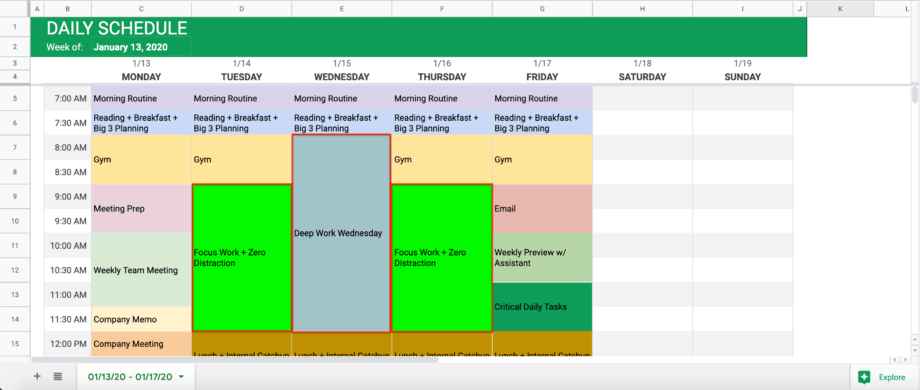Do you wish you had more time in your day? Daily time blocking is one of the most productive disciplines you can grow in as a busy person with lots to do.
After more than two years of consistent daily time blocking, I can say with confidence that it works.
**UPDATE** I have updated the daily time blocking template for 2024, so when you download it today, you can get started right away!
And, as a bonus to you, I’m sharing my daily time blocking template for free! It’s the perfect tool to get you started on the right path.
Key Takeaways
- Daily time blocking is the discipline of time management and involves the practice of breaking your day into blocks that are dedicated to specific tasks.
- Time blocking reclaims lost time during your day by giving you clarity on your tasks, permission to focus on important goals and a renewed sense of control over your work.
- The best, most productive leaders use time blocking to get more done with less effort and stress. You can start today with my 100% free daily time blocking template.
Time Blocking Solves a Big Problem
Overwhelm is a big problem for busy people who like to get things done. Tell me if this sounds familiar.
It’s only 8am, and you are already stressed. Your face can’t hide the storm raging inside of you.
Your todo list is piled sky-high. You stare blankly at the tasks you need to get done and don’t know where to start. It’s your living nightmare.
You can’t seem to catch up, and worse yet, you don’t know what to work on that will give you the feeling of being caught up.
You experience the uncomfortable sensation of spiraling out of control, and you can’t stop it.
Dread kicks in, and that one bad habit you thought you had “kicked to the curb” resurfaces with a vengeance.
You’re left feeling trapped and distraught, and you don’t know what to do to make it better.
I get it – overwhelm is a miserable feeling. It leads to stress, poor health, bad habits and numerous other negative side effects that prevent you from giving 100% to your work.
But, I am here to tell you there is a solution, and it’s called time blocking.
What Is Daily Time Blocking?
Daily time blocking is the discipline of time management. It works by breaking your day into blocks dedicated to a specific task or group of tasks.
It’s you in control of your day rather than your day in control of you.

Daily time blocking is a companion to your task list. It gives structure to the tasks you need to get done, and it gives you permission to do them at pre-defined intervals throughout your day.
Why Daily Time Blocking?
I have three primary reasons why daily time blocking is game-changing for leaders, managers and anyone who wants to get more done in less time.
1. Time Blocking Gives You Great Clarity
Because leaders and managers are so busy, we lack clarity on the next best thing to be doing.
And when we lack clarity on the next best thing, we feel guilty for working on anything not urgent. That in turn leads to tunnel vision, organizational blindness and reactive responding.
You need clarity to lead well. Time blocking gives you clarity by reducing the amount of decisions you need to make throughout the day.
Time blocking is your way of communicating to yourself what’s important, and when do you this, you grant yourself great clarity of purpose and resolve.
2. Time Blocking Gives You Permission to Focus
This sounds silly and counter-intuitive. After all, YOU are the leader or manager with control of your schedule.
And yet that is precisely the problem. The lack of boundaries in your position naturally restricts your ability to properly focus.
You have a million different things you could be doing, but only a handful of those things are actually impactful and move the needle.
Time blocking frees you to focus on high leverage work. It gives you permission to work on the things that matter most.
3. Time Blocking Gives You a Sense of Control
Notice how I didn’t say “Time blocking gives you control”. Don’t chase that illusion. It will always leave you empty handed.
However, what daily time blocking does offer is a sense of control, and that is highly valuable.
Time blocking establishes an inner calm – the exact opposite of overwhelm.
Think of it this way: time blocking is you saying “Yes” and “No” ahead of time, without the pressure of being in the moment. So, when the moment comes, the answer is easy, clear and uneventful.
That’s powerful enough to make you say “Yes” to daily time blocking, so let’s dig into the details of making it work for you!
Daily Time Blocking Strategy
Before we dive into the strategy, make sure to download my free daily time blocking template. I’ll be referencing it frequently. You can get instant access by clicking on this link here.
Morning Routine

If you’ll notice in the template, I begin every morning with a morning routine. There’s plenty of evidence to demonstrate that morning routines enhance your productivity and focus throughout the day.
A better way to put it: morning routines give you the best chance at success in your day.
Depending on your stage of life, your morning routine may be longer or shorter. I have small children, so 30 minutes is my target, but I am satisfied with 10 or 15.
What do you put in a morning routine? It’s varies for each individual. I spend time reading, reflecting, selecting my daily “Big 3” and praying. The important consideration is that you be consistent. Consistency compounds your performance over time.
The prevailing thought should be “Now I’m ready” when your morning routine has concluded. Whatever puts you in that state of mind consistently – add it to your morning routine.
Task Batching
Mondays are busy for me. I have a lot of meetings, but it’s on purpose.
Why? Two words: task batching.
Task batching is the art of grouping and completing similar tasks in a specific period of time. I batch all of my planning and meetings on Mondays. Because these tasks depend on one another (you must plan ahead to have successful meetings), it’s easy to group them together.
Task batching works because it helps you achieve the mental state of “flow”. You can concentrate intensely on one type of task, get “in the zone” and be far more productive.
And, because you are already using daily time blocking with a morning routine, you are physically and mentally prepared for that type of task.
This is why Mondays, though long, are far easier for me than they might otherwise be. I’ve put as many meetings as possible in the day so that the rest of my week is freed up from them.
This works for many types of tasks: email, check-ins, writing, reading, etc. I encourage you to consider all the types of tasks you engage in throughout the week, then be intentional about how you schedule them into your days. Batch where you can, and I guarantee you’ll reduce overwhelm and boost productivity.
Focus Work & Deep Work

As leaders and managers, we need uninterrupted time to think clearly and work diligently.
Without explicitly scheduling dedicated time for focus or deep work, it will never happen. Something “urgent” will always pop up.
This is why you must include intentional focus work and deep work time into your daily time blocking schedule.
Focus Work
My focus work consists of tasks or projects that need uninterrupted time in order to make meaningful progress.
For me, those tasks include new company initiatives, writing internal newsletters, reviewing KPIs and spreadsheets, inspecting data and surveys for trends, testing new concepts or features, etc.
These tasks need my 100% focus because they are impactful and move the needle. I couple this type of time block with distraction minimizing software. There are plenty of them out there. I personally use Focus for Mac.
Focus work should be time blocked for a minimum of 1 hour. Where possible, I like to do 2 and 3 hour focus work stretches. You should aim for the same.
Deep Work
Deep work, a term coined in a book called Deep Work by Cal Newport, is the ability to work in a state of deep concentration and focus for an extended period of time.
You may wonder about the difference between focus work and deep work, so let me answer that question for you.
Focus work boosts productivity. Deep work boosts competitive advantage.
The goal of deep work is for you to dedicate time to improving your competitive advantage. Deep work often includes tasks like long-term strategy planning, process improvements and end-to-end solution mapping.
It’s time focused around working on your organization, not in your organization.
Because I know how important competitive advantages are, I have an entire day dedicated to deep work each week. Deep work means no distractions or meetings of any type (internal or external).
The freedom to concentrate on high impact work is immense when it is done purposefully through deep work time blocking. If you aren’t doing it yet, figure out how to do it as soon as you can.
You won’t regret it.
Buffer Periods
Your daily time blocking schedule should include buffer periods. Buffer periods are specific blocks of time that space out your day.
Sometimes, your task involves driving to meet a client or having lunch with an associate. You know it has the potential to run long, so you add a buffer period after it in order to retain that sense of control over your day.
I find buffer periods especially helpful after lunches, gym time or extended strings of meetings. They help me regroup, recalibrate and refocus on the next tasks for the day.
Buffer periods should never be more than 30 minutes, and I use them at most twice per day.
If I have extra time during the buffer period, I catch up on small tasks like email or move straight into the next item on the schedule.
Cascading Messages
Every leader or manager must communicate both upwards and downwards throughout the day. Information you’ve received must be disseminated to the appropriate parties, and I call task cascading messages.
I typically block off 30 minutes near the end of the day for cascading messages. These messages can include new revelations, important changes to projects, email correspondence updates, follow-ups, upcoming tasks that need attention and the like.
I would also encourage you to build consistency into this type of time block. Do it every day at the same time so that your people expect it. It’s a simple and effective way to build trust within your organization.
Shutdown Routine
Finally, in a similar vein to a morning routine, you need a shutdown routine in your daily time blocking schedule.
Shutdown routines give closure to your work day. No matter what has happened during the day, a good and consistent shutdown routine helps you process it, deal with it and archive it.
If you’ve ever wondered how to disconnect yourself from work when you get home, a shutdown routine is an effective way to do just that.
In my shutdown routine, I journal about the day using Michael Hyatt’s Full Focus Journal. Then, I read a book (typically about business or leadership) and conclude the work day.
My shutdown routine is only 30 minutes, but those 30 minutes are precious. It produces a night and day difference in my ability to give attention to my family and friends after work.
How to Get Started with Daily Time Blocking
You are now ready to begin daily time blocking. Get ready to banish overwhelm and experience inner calm!
First, make sure you have downloaded my free daily time blocking template. It’s battle-tested (I’ve used the exact same one you will receive for more than a year), flexible and prints on a single page in landscape mode.
Second, watch the video below. I talk through the daily time blocking template, show you how to import it into Google Sheets or Microsoft Excel and give you some quick hacks to help you customize it.
Third, print out a physical copy of your daily time blocking schedule. My free daily time blocking template prints on a single page in landscape mode.
The reason why you want to print it out is simple: you won’t be good at first. It will take time for you to learn how you can operate at optimal productivity and impact.
Make check marks on the blocks you complete successfully and X’s on the ones you don’t. As you review, you will discover trends that highlight how you need to adjust your time blocks. Be prepared to adjust many times the first 4-6 weeks.
Finally, give yourself some grace when you miss the mark. You will miss the mark, but the important thing is to keep showing up. In time, you will learn your rhythms and become the master of your schedule.
I love daily time blocking. As a leader, it’s helped me reduce overwhelm and increase confidence in my ability to get things done. I’m confident it will work for you too.
If you have any questions or thoughts, please feel free to contact me and connect with me on Twitter.
Also, if you’ve found this helpful, please share the article with others. It’s the best way to pay it forward for the value you’ve received. You can do that by using the Facebook, Twitter, LinkedIn and email share buttons available.
Until next time,
Thomas

P.S. I send out a newsletter called The Better Leader Newsletter. It’s filled with engaging and insightful content designed to help you flourish as a leader. If you are interested, click here to learn more and sign up. Thanks!






Leave a Reply